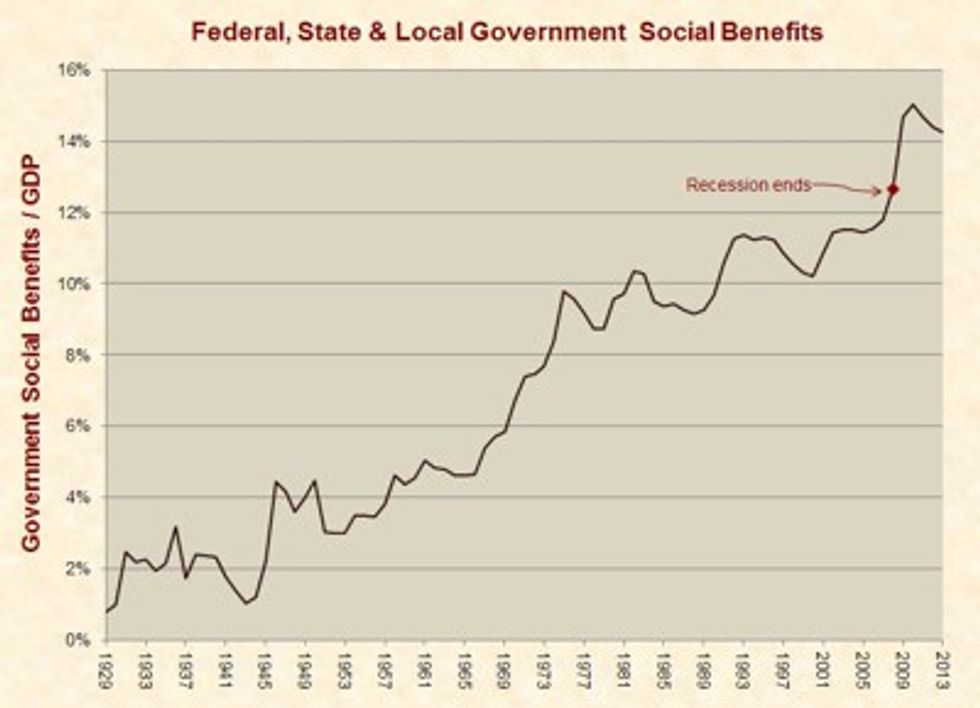Jeb Bush recently ignited a political firestorm by making the following comments about economic growth and work:
My aspiration for the country—and I believe we can achieve it—is 4 percent growth as far as the eye can see. Which means we have to be a lot more productive, workforce participation has to rise from its all-time modern lows. It means that people need to work longer hours and, through their productivity, gain more income for their families.
Other presidential candidates and pundits of all political stripes pounced on these remarks. Hillary Clinton, for example, declared that "Anyone who believes Americans aren't working hard enough hasn't met enough American workers."
A spokesman for Ted Cruz's campaign said, "The problem is not that Americans aren't working hard enough. It is that the Washington cartel of career politicians, special interests and lobbyists have rigged the game against them."
 Republican U.S. presidential hopeful and former Florida Governor Jeb Bush speaks during the 'Road to Majority' conference June 19, 2015 in Washington, DC. (Photo by Alex Wong/Getty Images)
Republican U.S. presidential hopeful and former Florida Governor Jeb Bush speaks during the 'Road to Majority' conference June 19, 2015 in Washington, DC. (Photo by Alex Wong/Getty Images)
Fox News commentator Eric Bolling stated that Bush "was right with labor participation" but "wrong with hours worked, and he was wrong with productivity. Those things are very strong."
And New York Times columnist and Nobel prize-winning economist Paul Krugman called Bush's words "ludicrous."
The clear lesson it that it is politically dangerous to tell voters that they need to work harder, even though the latest data from the Census Bureau's American Time Use Survey show that U.S. residents aged 15 and older now spend an average of:
- 4.0 hours per day on income-generating work and obtaining education, and
- 5.3 hours per day on leisure and sports activities like watching TV, socializing, and exercise.
Political posturing aside, Bush's observations are consistent with the facts of these matters, and they have exceedingly important implications.
First, consider the importance of economic growth and productivity. Per textbook "Microeconomics for Today," countries with low economic growth "are less able to satisfy basic needs for food, shelter, clothing, education, and health." Likewise, it's hard to overstate the import of productivity. In the words of:
- Federal Reserve Chair Janet Yellen, "The most important factor determining living standards is productivity growth."
- U.S. Bureau of Labor Statistics economist Betty W. Su, "High productivity growth" affords people with a "higher standard of living and quality of life."
- the Congressional Budget Office, "A small change in the growth of productivity" over an extended period can do more harm than recessions, because low productivity reduces economic "output by an ever-increasing amount."
The nation's productivity affects all Americans, but it is especially vital for people with low incomes, because low-wage earners who live in nations with high levels of productivity have much better living standards than their peers in less productive nations. There are many ways to demonstrate this, but one of the clearest involves the purchasing power of McDonald's workers. In the United States, McDonald's workers can buy about 2.4 Big Macs with their earnings from an hour of work, but this drops to:
- 2.2 Big Macs in Western Europe,
- 0.8 Big Macs in Eastern Europe, and
- 0.4 Big Macs in Latin America.
This amounts to a staggering 500 percent premium in purchasing power in the U.S. versus Latin America. As documented by Princeton economics professor Orley C. Ashenfelter, McDonalds' workers across the world perform the same jobs with the same levels of productivity, but because they live in societies with vastly differing levels of productivity, these workers have vastly different standards of living.
With the facts above in mind, consider these disturbing trends in economic and productivity growth since the Great Recession ended in June 2009:
- From 2010-2014, real economic growth has averaged 35 percent below the average of the 50 years prior to the Great Recession.
- From 2010-2014, productivity growth averaged 58 percent below the average of the 50 years prior to the Great Recession.
- From 2010-2014, productivity growth is the lowest it has been in any five-year period except from 1977 to 1982 for as far back as such data extends (1947).
The preliminary outlook for 2015 is just as bleak or worse.
The U.S. Department of Labor has announced that productivity actually dropped at a 3.1 percent annual rate in the first quarter of 2015. Also, the Federal Reserve recently downgraded its 2015 growth forecast for gross domestic product growth to a range of 1.8 to 2.0 percent. This represents a sharp decline from its previous forecast in March of 2.3 to 2.7 percent, which was already well below the prerecession 50-year average of 3.4 percent.
Such outcomes are especially troubling given that the economy typically performs well in the wake of recessions. In fact, a decade ago, Paul Krugman argued that "the economic expansion under President Reagan did not validate his economic doctrine," because "rapid growth is normal when an economy is bouncing back from a deep slump." (Hat tip: Larry Elder)
Given the size and sophistication of the U.S. economy, the reasons for the current economic weakness entail many complexities, but they all boil down to the two simple points Bush mentioned: (1) how much people work and (2) how effectively they work. These factors form the very definition of economic output. Per the textbook "Economics: Principles and Policy," "GDP = Hours worked × Labor productivity."
America's total work hours and productivity tend to increase over time due to population growth and the advance of technology, but the rate of increase for both have been feeble compared to the past, and hence, so has economic growth.
Many factors can affect work hours and productivity, but three of the most direct and drastically changing over recent years are government debt, regulations, and social programs. As shown below, all of these have undergone pronounced changes that may explain why the U.S. (and other nations) are experiencing weak economic growth.
The Impact of Government Debt
One of the surest paths to decreased productivity is excessive government debt, and federal debt has recently grown at a faster rate and to higher levels than at any time in U.S. history except World War II. Worse yet, unlike the World War II debt—which rapidly declined in its aftermath—the current debt is slated to skyrocket to unprecedented levels under current federal policies.
One of the primary reasons government debt harms productivity is that it diverts money away from investments that increase productivity. In the words of CBO, "Because federal borrowing generally reduces national saving, the stock of capital assets, such as equipment and structures, will be smaller and aggregate wages will be less than if the debt were lower."
Visit
USADebtClock.com to learn more!
Similarly, CBO estimated in 2009 that Obama's stimulus would have a positive short-term effect on GDP and a negative long-term effect (starting in 2015), because when "people hold their wealth as government bonds rather than in a form that can be used to finance private investment, the increased debt will tend to reduce the stock of productive private capital."
There are multiple mechanisms by which government debt can harm economic growth, and contrary to what some journalists and pundits have alleged, the connection between government debt and economic growth is robust and compelling. Media outlets have widely reported on research from the Political Economy Research Institute said to prove that large national debts don't harm economic growth—but in reality, this research showed what previous research had found: economic growth decreases by an average of about 30 percent when government debt exceeds 90 percent of an economy. The authors of this research, however, buried this data deep within their paper and published a misleading overview, which the media uncritically parroted.
Notably, the U.S. national debt surpassed 90 percent of GDP in 2010 and now stands at 103 percent. Likewise, the Eurozone and Japan have respective debts of 93 percent and 245 percent of GDP, and both of them are suffering from weak productivity gains.
The Impact of Regulations
Another key hindrance to productivity is laws and regulations that prohibit people from using cost-effective means of production or divert them from work to comply with red tape. The ostensible purpose of most laws and regulations is to provide benefits for society or certain segments of it, but to accomplish this, they typically use the force of law to make people act in ways that they normally would not. This often entails some sort of economic tradeoff that impairs productivity.
The Obama administration has issued a report estimating the costs and benefits of major federal regulations from 2003 to 2013. This report states that the costs were somewhere between $57 billion and $84 billion, while the benefits were much greater at $217 billion to $863 billion.
 (AP Photo/Susan Walsh)
(AP Photo/Susan Walsh)
Conversely, the authors of a 2013 paper in the Journal of Economic Growth conducting a study finding that the effects of federal regulations on the U.S. economy have been "negative and substantial." They estimate that GDP would now be more than three times larger if federal "regulation had remained at its 1949 level."
In truth, the costs and benefits of regulations are often impossible to objectively measure. As explained in the textbook "Microeconomics for Public Decisions," it can be "relatively easy" to craft a cost-benefit analysis to "produce a desired outcome," and "it is practically impossible to predict all the future impacts" of a government program, "let alone their magnitudes and their probabilities of occurrence."
One thing, however, is certain: People have an innate motive to maximize their productivity in order to maximize their income, and governments often restrict this to achieve certain social goals or a common good. Also, every minute that workers spend complying with government mandates is a minute that they don't spend producing goods and services. Some examples of such dynamics include:
- federal tax laws and regulations, which require taxpayers to spend 6.1 billion hours per year filling out forms and performing other tax compliance tasks. For a sense of scale, this is more than the combined work time of every K-12 teacher in the U.S.
- healthcare regulations, which require 40 layers of paperwork for a typical Medicare patient who arrives at an emergency room with a broken hip and receives treatment until recuperation.
- greenhouse gas regulations, which the U.S. Energy Information Administration projects will add 30 percent to the price of electricity by 2022.
- unionization laws, which force employers to fix labor prices and exclude competition, leading to higher consumer prices and lower standards of living.
That said, major federal laws and regulations have abounded in recent years. Again, it is notoriously difficult to accurately quantify them, but when Obama entered office in 2009, he had a 79-seat Democratic majority in the House and an effective 18- to 20-seat majority in the Senate. For two years, this gave him ample power to enact his agenda on a broad range of issues.
Even after Democrats lost control of Congress, Obama promised to use his "pen" and "phone" to further his aims, and he has done just that. Supporters and critics of Obama heatedly debate the merits and downsides of his actions, but both agree that they have been far-reaching and substantial. Hence, they likely are having pronounced effects on productivity.
Significantly, the only time in modern U.S. history when productivity growth was worse than it is now occurred in the wake of a major regulatory expansion in the 1970s.
The Impact of Social Programs
The impact of social programs on work hours has been plainly stated by Lawrence Summers, president emeritus of Harvard University, former chief economist to Obama administration, and former Treasury secretary under Clinton. He wrote that "government assistance programs" provide people with "an incentive, and the means, not to work."
In recent years, spending on government assistance programs, technically called "social benefits," have consumed more of the U.S. economy than ever recorded in the nation's history:
 (Just Facts)
(Just Facts)
In keeping with this expansion of social program spending, the U.S. is currently at or near modern lows in:
None of this is surprising. As detailed by CBO, government assistance programs:
- provide benefits that decline with rising income, "thus making work less attractive."
- allow "people to maintain the same standard of living while working less."
- lead to increased taxes, which "ultimately induce some workers to supply less labor."
These realities apply to adults of all ages, including senior citizens, who have experienced significant increases in life expectancy without corresponding increases in the ages at which they begin to collect Medicare and Social Security. For example, since the outset of the Social Security program, the average male retiree has enjoyed a 43 percent increase in the amount of time collecting Social Security benefits.
The Combined Impact
Economists of all political persuasions have expressed concern over the current dismal state of economic and productivity growth. Government debt, regulations, and social benefits are likely not the only causes of this, but each of them is significant in its own right, and in combination, they can be toxic to living standards. This is because they all impede productivity or reward idleness.
Relative to other developed nations, the U.S. ranks 19th out of 34 in labor force participation and 15th of 33 in annual work hours per worker. These are in the middle of the pack, but because the U.S. ranks 4th out of 43 nations in productivity per hour of work, it ranks 6th in average income per person.
Experience has shown that this could change. In 1960, America led the world by a wide margin in GDP per person, producing 30 percent more than the next closest nation. It is now 11th among 226 countries.
In sum, whether or not Americans or any other people improve their living standards will boil down to how much they work and how productively they do it. Current trends are not promising, but individuals have the power to make a difference for themselves and others through their work ethic, ingenuity, and the political leaders they elect.
James D. Agresti is the president of Just Facts, a nonprofit institute dedicated to researching publishing verifiable facts about public policy.
–
TheBlaze contributor channel supports an open discourse on a range of views. The opinions expressed in this channel are solely those of each individual author.


 Republican U.S. presidential hopeful and former Florida Governor Jeb Bush speaks during the 'Road to Majority' conference June 19, 2015 in Washington, DC. (Photo by Alex Wong/Getty Images)
Republican U.S. presidential hopeful and former Florida Governor Jeb Bush speaks during the 'Road to Majority' conference June 19, 2015 in Washington, DC. (Photo by Alex Wong/Getty Images)
 (AP Photo/Susan Walsh)
(AP Photo/Susan Walsh)
 (Just Facts)
(Just Facts)


